Last month I left off with a look into my Heart Rate Variability (HRV) during the taper for Ironman Coeur d’Alene (IMCdA). Now that the event is done, we can look at the effects of the race on my HRV, the recovery period that follows and the preparation for my next race. But, before we get into that I guess you may want to know a little about how the Ironman Coeur d’Alene event went.
IMCdA Race Summary
I won’t get into the full details of my IMCdA race here, so for that you can jump over to the full race report on my blog here. The weather forecast for Coeur d’Alene heading into race day was expected to reach a high of 107° F (~42° C) due to a seasonally abnormal heat wave affecting the Pacific Northwest area of the United States. I am not one who does well in heat to begin with and this was well beyond my operating temperature range. The reason I chose IMCdA was due to its’ typically cooler weather and the similarity of terrain to Ironman Lake Placid. What I got was something totally different.
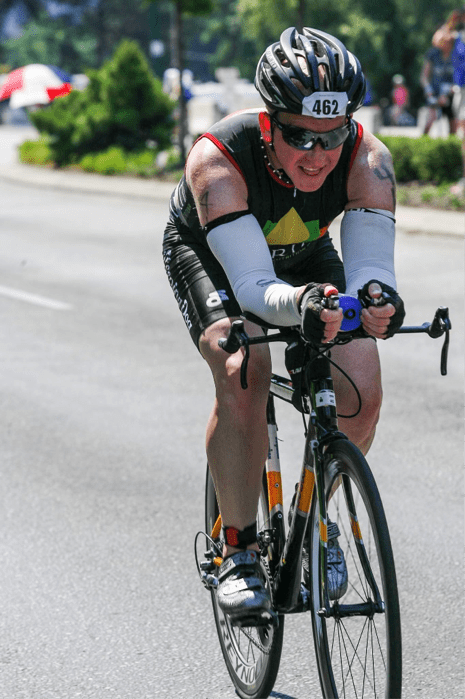 The race start time was adjusted to 5:45am, an hour earlier, in an effort to avoid the heat. Well, maybe for the pros, but this just meant more running time in the hottest part of the day for me. The day started out pretty well. I had a really great swim and knocked 2 minutes off my previous IM swim PR. The bike went extremely well too on the first 56 mile loop, finishing in under 3 hours and with my average power about 10 watts under my goal wattage. Then, the sun came to full strength and the heat kicked up. At mile 85 on the bike I vomited three times after taking big mouthful of some very hot hydration drink during a climb. Things really deteriorated after that.
The race start time was adjusted to 5:45am, an hour earlier, in an effort to avoid the heat. Well, maybe for the pros, but this just meant more running time in the hottest part of the day for me. The day started out pretty well. I had a really great swim and knocked 2 minutes off my previous IM swim PR. The bike went extremely well too on the first 56 mile loop, finishing in under 3 hours and with my average power about 10 watts under my goal wattage. Then, the sun came to full strength and the heat kicked up. At mile 85 on the bike I vomited three times after taking big mouthful of some very hot hydration drink during a climb. Things really deteriorated after that.
I managed to still pull out a decent 6:20 bike split, but I was really hot when I entered the transition tent. I took my good old time as the volunteers were throwing ice cold towels over me. After about 15 minutes in transition, I finally made my way out onto the run course. My run went from running the first 2-3 miles, to a run/walk on the next 3 miles, and finally to just walking the remainder of the first 13.1 miles of the run course. My legs were cramping up every time I tried to run. When I came back into town, I had started considering the option of dropping out at this point. I really could not bear the thought of walking another 13 miles in the heat. After chatting with my wife for a bit, the decision to drop out became an easy one. I walked to the turnaround and kept going straight into transition.
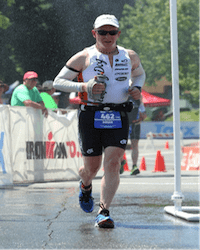
While the decision was a difficult one, I got over fairly quickly. I have finished two previous Ironman’s in Lake Placid and I had a goal time for this race, so when that became unreachable my motivation to continue had waned.
The Post-Race Recovery HRV Analysis
So, despite the DNF, I still put in around a 11½ hour, 128 mile day in 107°F temperatures. I was pretty wiped out at the end of the day and expecting to see some pretty low HRV numbers the following morning. The chart below shows my daily HRV tracking & Training Stress Score (TSS) from the morning after race day until the most current date.
NOTE: Keep in mind that I increment the date by 1 day on the TSS data so that the previous days TSS data plots on the same day as the following days’ HRV value. So, here you can see the TSS from the race on June 28th is showing on June 29th, which is where the related HRV is recorded.
Figure 1-Ironman CdA 2015 HRV Recovery
One of the biggest surprises for me was the reading of 67 on the Monday morning after IMCdA. I expected a much lower number, although I really didn’t feel all that bad. Tuesdays’ reading of 40 was a bit more of what I expected on Monday. Perhaps it was a bit of delayed in the onset of fatigue. Although I did go to the brewpub in town on Monday and enjoyed a few craft IPA’s, which could have caused the larger dip in HRV.
My HRV actually rebounded fairly quickly post-Ironman. Other than the 40 reading, it quickly jumped back up into the 70’s while we enjoyed our week in Coeur d’Alene and made a short trip over to Glacier National Park for some photography and short hikes.
After returning back home on the second week, I gave myself a few more days of recovery but since I was feeling good, my HRV was decent, and I had another race to get ready for so I started back in on some more training.
My next race is the Steelman Olympic Triathlon near Quakertown, PA on August 16th, 2015. I haven’t done this race since pre-Ironman in 2012, so I was curious to see how I have improved since then. Since this is a shorter distance race, I would be focusing highly on intensity and speed for the next 3-4 weeks in preparation for it. I figured I have plenty of endurance base at this point.
Referring back to the graph above, you can see that my systems are responding quite well the shorter volume and high intensity workouts. HRV values have been consistently up in the high 80-90’s for the most part. I was going to slide a recovery week in there, but since I have been feeling so well I just took a couple rest days here and there. It seems to be working for sure.
Looking at my current Training Guide in ithlete Pro, you can see things were right where they need to be. I have not holding back intensity either. I have been doing a lot of intervals and tempo work. I have to say I am not used going that hard and it surely does hurt a bit.
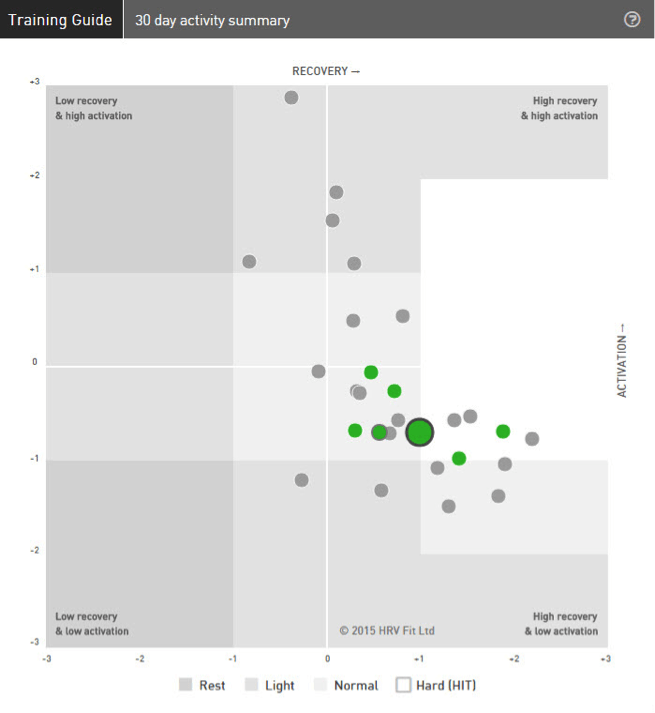
Figure 2- ithlete Training Guide Chart as of July 31, 2015
Historical Comparisons
Here is a look at my recovery period after last years (2014) Ironman Lake Placid event. Here I had a pretty low HRV (50) the day after the race and then a pretty quick increase in the 6 days that followed. Things kind of dropped off again as I started some lighter training heading into Timberman 70.3 on August 17th (TSS plotted on the 18th). I ended up bagging a 30 min PR on my Half-Iron distance at this race too. I also stopped taking recording my HRV due to problems that were occurring in the application that I was using back then. One reason I went out in search of a replacement app. Thank you ithlete!
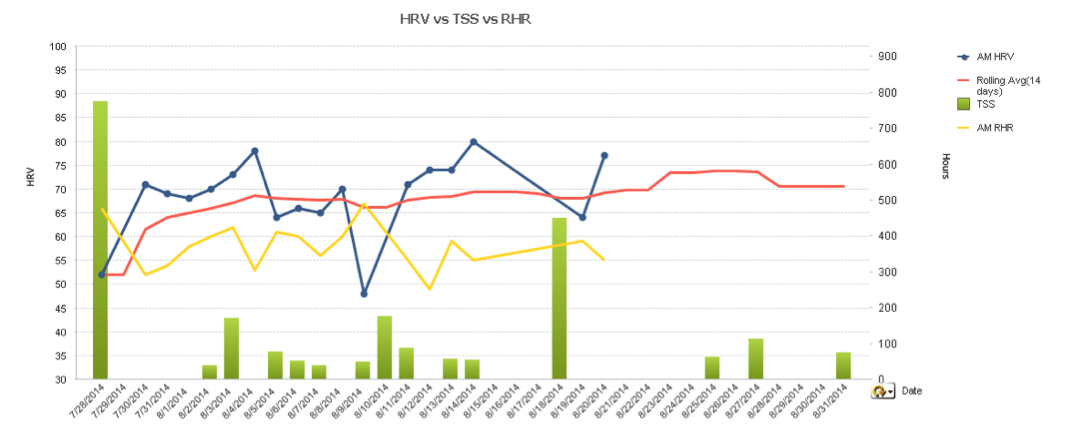
Figure 3-Ironman Lake Placid 2014 HRV Recovery
Below is Ironman Lake Placid 2013 recovery. In 2013 I had a really low HRV on the morning after race day but things recovered after a few days and then it was a deep dive into the off-season. I also stopped recording HRV after that.
Figure 4-Ironman Lake Placid 2013 HRV Recovery
So, now I am heading into possibly my last race of the season. I have nothing planned and am not really sure what I am doing after that. I have not raced an Olympic distance in a while, so Steelman should be interesting. If anything it will be nice to just let it rip and not have to worry about race nutrition for a change.

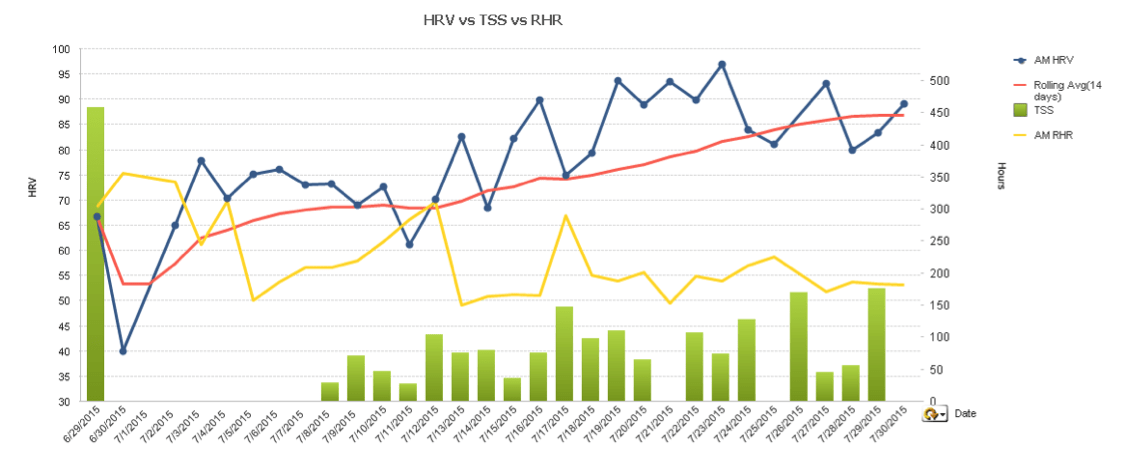
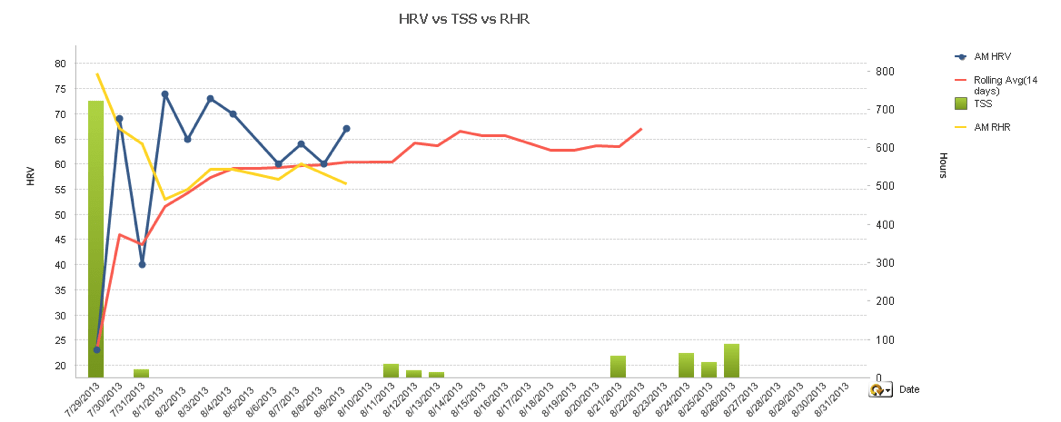
Great blog Brian! I can relate to and very much sympathise with the event heat suffering you went through. The Etape this year reached 41C on the climb up to La Toussuire and I got very close to quitting when I spotted an animal drinking trough at the side of the road. Although already occupied by another cyclist, I immersed fully, and after a few mins set off again with a HR 30 beats lower.
Also interestingly, I saw only 1-2days hit on HRV followed by super compensation and a few weeks of good form, just like you. Not sure it’s worth those very unpleasant feelings and the highest Training Load I’ve ever recorded though!